
Oslo Metro rolling stock
Encyclopedia
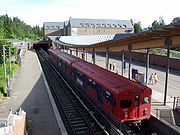
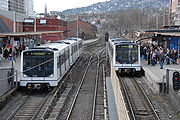
Norway
Norway , officially the Kingdom of Norway, is a Nordic unitary constitutional monarchy whose territory comprises the western portion of the Scandinavian Peninsula, Jan Mayen, and the Arctic archipelago of Svalbard and Bouvet Island. Norway has a total area of and a population of about 4.9 million...
has consisted of three classes: T1000/T1300, T2000 and MX3000
MX3000
MX3000 is an electric train used on Oslo Metro in Oslo, Norway. The multiple units are produced by Siemens, who started serial delivery in 2007. Seventy-eight three-car units have been ordered by Kollektivtransportproduksjon, and five by Akershus County Municipality. They replaced the older T1000...
. The T1000 was built as 162 single cars from 1964 to 1978. From 1979 to 1985, 33 new T1300 trains were built, followed by the conversion of 16 T1000s. Six two-car T2000 units were delivered in 1994. Since 2005, the first 83 three-car MX3000 units have been replacing the older stock, and the last T1000 was retired in 2007. From 2010, only MX3000-trains are in use. The T1000/T1300 and T2000 were built by Strømmens Værksted
Strømmens Værksted
Strømmens Værksted A/S was an industrial company based in Skedsmo, Norway, specializing in the production of rolling stock. Founded in 1873, it remains as a part of Bombardier Transportation...
, with motors from Norsk Elektrisk & Brown Boveri
Norsk Elektrisk & Brown Boveri
Norsk Elektrisk & Brown Boveri A/S also known as NEBB was a Norwegian manufacturing company, which built a large amount of the rolling stock that is used by Norges Statsbaner. The plant was located at Skøyen. In 1988 it merged into Asea Brown Boveri ....
(NEBB) and AEG
AEG
Allgemeine Elektricitäts-Gesellschaft was a German producer of electrical equipment founded in 1883 by Emil Rathenau....
, respectively, and the MX3000 were built by Siemens
Siemens AG
Siemens AG is a German multinational conglomerate company headquartered in Munich, Germany. It is the largest Europe-based electronics and electrical engineering company....
.
All trains receive 750 V DC from a third rail
Third rail
A third rail is a method of providing electric power to a railway train, through a semi-continuous rigid conductor placed alongside or between the rails of a railway track. It is used typically in a mass transit or rapid transit system, which has alignments in its own corridors, fully or almost...
shoe, while the T1300 and T2000 also have pantographs
Pantograph (rail)
A pantograph for rail lines is a hinged electric-rod device that collects electric current from overhead lines for electric trains or trams. The pantograph typically connects to a one-wire line, with the track acting as the ground wire...
. This allows the latter to also operate on the suburban lines of the Oslo Tramway, which the western part of the current metro was part of until 1995. All trains feature automatic train protection
Automatic Train Protection
Automatic Train Protection in Great Britain refers to either of two implementations of a train protection system installed in some trains in order to help prevent collisions through a driver's failure to observe a signal or speed restriction...
and step-free access
Accessibility
Accessibility is a general term used to describe the degree to which a product, device, service, or environment is available to as many people as possible. Accessibility can be viewed as the "ability to access" and benefit from some system or entity...
from the platforms. Trains can operate up to six cars in length. The T1000/T1300 and MX3000 are capable of 70 kilometres per hour (43.5 mph), while the T2000 can operate at 100 kilometres per hour (62.1 mph). The T2000 introduced articulated car
Articulated car
Articulated cars are rail vehicles which are consist of a number of smaller, lighter cars which are semi-permanently attached to each other and which share common trucks. They are much longer than single passenger cars, and on the TGV Réseau, for example, 8 cars are joined this way...
s, while the MX3000 introduced regenerative brake
Regenerative brake
A regenerative brake is an energy recovery mechanism which slows a vehicle or object down by converting its kinetic energy into another form, which can be either used immediately or stored until needed...
s and air conditioning
Air conditioning
An air conditioner is a home appliance, system, or mechanism designed to dehumidify and extract heat from an area. The cooling is done using a simple refrigeration cycle...
. The T1000/T1300 and MX3000 can be run in multiple
Multiple-unit train control
Multiple-unit train control, sometimes abbreviated to multiple-unit or MU, is a method of simultaneously controlling all the traction equipment in a train from a single location, whether it is a Multiple unit comprising a number of self-powered passenger cars or a set of locomotives.A set of...
with each other, but not with the T2000. The MX3000 replaced the red color scheme with a white livery.
History
In 1954, the Oslo City Council decided to build a four-line metro to the new suburbs to the east of the city center. The plans called for the system to open in 1966, with the conversion of the Østensjø Line and the Lambertseter Line of the Oslo Tramway, and the new Furuset Line and Grorud Line. The system would feature higher and longer platforms, allowing step-free access to six-car trains, automatic train protection and third-rail power supply. This would make the metro incompatible with the existing tramways in Oslo. The first units in the T1000 series were two single-car prototypes designated T. They were test-run on the existing tramways from 1959 to 1960, and were then put into service on the Kolsås Line. Prone to technical faults, they were taken out of regular service in 1982.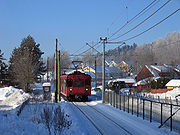
Oslo Sporveier was highly satisfied with the SL79
SL79
SL79 is a class of 40 articulated trams operated by the Oslo Tramway of Norway. The trams were a variation of the Duewag trams that had been developed by the German manufacturer since the 1950s. The six-axle vehicles are unidirectional with four doors on the right side. The trams can seat 77...
articulated trams that had been delivered during the 1980s. In 1985, work started on the development of a modified version for the western suburban lines. The stock on the Holmenkollen and Kolsås Lines were the first that needed to be replaced. At the same time, the company wanted to make the trains compatible with the metro so they could operate on both systems. The new stock was considered to be a trial; if it met performance expectations, future orders could be made to replace the T1000 stock, after the latter reached the end of its economical life in about 2000. The required specification for the new train was published in October 1988.
In the late 1980s, it was decided to upgrade the Røa and Sognsvann Lines to metro standard. This would allow them to use T1000 stock. Twelve T2000 were ordered in 1991, and would be sufficient to operate the services on the Holmenkollen and Kolsås Lines, that would retain an overhead wire. The development costs for the T2000 were in part subsidized by the government, as the high-tech product from Strømmens Verksted (by then part of the ABB Group) and AEG was seen as a future export product. The trains were delivered in 1994 and taken into use in 1995. The same year, the metro started operating all services through the city center, connecting the western and eastern networks.
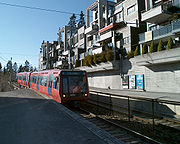
Akershus
- Geography :The county is conventionally divided into the traditional districts Follo and Romerike, which fill the vast part of the county, as well as the small exclave west of Oslo that consists of Asker and Bærum...
and Oslo started. Oslo Package 2
Oslo Package 2
The Oslo Package 2 or O2 is a political agreement for financing investments in public transport in Oslo and Akershus, Norway. The program runs from 2001 to 2011, and includes many large and small investments in railways, the Oslo Tramway, the Oslo Metro and infrastructure for buses. Total budget is...
was passed in 2001 and allowed municipal and state grants to be supplemented by increased fare and toll road
Fjellinjen
Fjellinjen AS is a municipal company owned by the City of Oslo and Akershus County Municipality . It is responsible for the collection from the toll ring around Oslo, with a total of nineteen toll plazas.-History:...
revenue to finance, among other things, new trains for the metro. The initial order by Oslo Sporveier
Oslo Sporveier
Kollektivtransportproduksjon AS is a municipal owned public transport operator of Oslo, Norway, the name meaning simply "public transportation producer". It operates the trackage and maintains the stock of the Oslo Metro and Oslo Tramway, as well as owning eight operating subsidiaries...
in 2003 from Siemens
Siemens AG
Siemens AG is a German multinational conglomerate company headquartered in Munich, Germany. It is the largest Europe-based electronics and electrical engineering company....
was for 33 units (99 cars), plus options for further orders. In 2005, the city council voted to replace all existing T1000 and T1300 stock with the MX3000, increasing the quantity by another 30 units. Two test units were delivered in October 2005, with the first serial deliveries in April 2007. With the delivery of the new white and gray trains, Oslo Sporveier received criticism that they had been disloyal to the old red color of the metro, and that they did not follow up on their former design concept from the 1960s through the 1980s. Following the 2006 decision to convert the Kolsås Line to metro standard, Akershus County Municipality announced they would order five units.
In November 2006, the city government proposed that the maintenance of the new trains be privatized
Privatization
Privatization is the incidence or process of transferring ownership of a business, enterprise, agency or public service from the public sector to the private sector or to private non-profit organizations...
. This resulted in protests from the employees, who campaigned by refusing to work overtime. As a result, after a few weeks, the company lacked 57 trains to provide adequate service. The issue was solved when the socialist opposition parties along with the Liberal Party agreed to postpone the matter until after all the new trains were delivered in 2009. As part of the agreement, a new limited company, Oslo Vognselskap, wholly owned by Kollektivtransportproduksjon, would take ownership of all metro trains and trams used by the operating companies. Responsibility for the debt accumulated for buying the trains is to be managed by Oslo Vognselskap, while operation and management of the maintenance contracts was transferred to Oslo T-banedrift.
In 2008, the city council in Oslo decided to upgrade the Holmenkollen Line to metro standard, to allow six-car MX3000 trains to be the main mode of transport to Holmenkollen Ski Jump
Holmenkollen ski jump
Holmenkollbakken is a large ski jumping hill located at Holmenkollen in Oslo, Norway. It has a hill size of HS134, a construction point of K-120, and a capacity for 30,000 spectators. Holmenkollen has hosted the Holmenkollen Ski Festival since 1892, which since 1980 have been part of the FIS Ski...
during the FIS Nordic World Ski Championships 2011. This will allow 9,000 people per hour to be transported to the sports venue. The first T1000 was scrapped on 14 March 2007, and the last T1000 train was run on 19 July 2009. Oslo Tramway Museum
Oslo Tramway Museum
Oslo Tramway Museum with 450 members. The museum also operates a heritage tramway in Vinterbro outside Oslo.LTF was founded in 1966, six years after the city council had decided to close down the tramway and trolleybus. This followed the closing of the Bergen Tramway, where only a single tram had...
has preserved six T1000 cars, no. 1002 (T1-2), 1018 (T1-2), 1076 (T1-1), 1092 (T2), 1129 (T3) and 1141 (T4). In 2008, the T2000 were taken out of service while the Holmenkollen Line was being renovated. In 2010, Ruten decided that they would not put back into service, largely because of high maintenance costs and low availability of spare parts because of the technically complex design and small series. The last T1300 was retired on 22 May 2010, after which only MX3000 units are used on the metro.
Specifications
The Oslo Metro uses 750 volt direct current fed to the train via a third rail, along a standard gaugeStandard gauge
The standard gauge is a widely-used track gauge . Approximately 60% of the world's existing railway lines are built to this gauge...
track. The system is not compatible to the Oslo Tramway, but the T1300 and T2000 have been built to run on both the suburban lines of the tramway and the metro. The platforms are 110 metres (360.9 ft) long, and the height of the train floors are 1.12 metres (3.7 ft) above the track, allowing step-free access to the platforms.
The trains' speed are controlled by an automatic train protection (ATP) system. The speed codes are transferred from the ATP points in the infrastructure, using 75 hertz pulses in the tracks. The trains pick up the signals via antennas. The speed codes are 15 km/h (9 mph), 30 km/h (18.6 mph), 50 km/h (31.1 mph) and 70 km/h (43.5 mph). They are communicated to the engineer via signals in the driver's cab; in addition, the system will automatically reduce the speed, should the limit be exceeded. The driver can put the trains in an automatic mode, where the train itself adjusts its speed to the limit. The driver is always responsible for starting and halting the train at stations.
T1000
The T1000 were built by Strømmens Værksted and is 17000 millimetre long, 3200 millimetre wide and 3650 millimetre high. Each car is equipped with two bogieBogie
A bogie is a wheeled wagon or trolley. In mechanics terms, a bogie is a chassis or framework carrying wheels, attached to a vehicle. It can be fixed in place, as on a cargo truck, mounted on a swivel, as on a railway carriage/car or locomotive, or sprung as in the suspension of a caterpillar...
s. The axle distance is 2170 millimetre, the bogie distance is 11000 millimetre and the wheel diameter is 820 millimetre. The cars are equipped with four 98 kW motors each from NEBB, giving a maximum speed of 70 kilometres per hour (43.5 mph). The weight is 27.74 tonnes (27.3 LT) and the electrical equipment was delivered by AEG
AEG
Allgemeine Elektricitäts-Gesellschaft was a German producer of electrical equipment founded in 1883 by Emil Rathenau....
. The T1300 differ in that they have a pantograph and were built for conductors. The seating also varies: T1000 has a total capacity of 180 passengers, of which 63 can sit. T5 has the same total capacity, but 70 people can sit. T6 has a capacity for 154 people, of which 64 can be seated. T7 and T8 have a capacity for 177 passengers, of which 60 can be seated. All models are capable of operating six cars in multiple, although they are commonly used in shorter configurations.
T2000
The T2000 was built by Strømmens Værksted and AEG as twin-car units. Each car's aluminum body is 18000 millimetre long, 3650 millimetre high and 3300 millimetre wide. The empty weight of a car is 31 tonnes (30.5 LT). Capacity is for 60 seated and 125 standing passengers. There is a driver's cabin at one end of each car. Passengers sit in two compartments; the forward has conventional 2+2 seating, while the back section has 1+2+1 seating with two aisles. Both cars have power on all axleAxle
An axle is a central shaft for a rotating wheel or gear. On wheeled vehicles, the axle may be fixed to the wheels, rotating with them, or fixed to its surroundings, with the wheels rotating around the axle. In the former case, bearings or bushings are provided at the mounting points where the axle...
s, giving a Bo'Bo'
Bo-Bo
A Bo-Bo or Bo′Bo′ is a locomotive with two independent four-wheeled bogies with all axles powered by individual traction motors...
wheel arrangement. Four motors, each with 143 kW, power the car, giving a top speed of 100 km/h (62.1 mph) and an acceleration of 1.3 m/s2 (4.3 ft/s2). The trains are equipped with both pantograph and third-rail shoe. The trains cannot be connected for multiple running
Multiple-unit train control
Multiple-unit train control, sometimes abbreviated to multiple-unit or MU, is a method of simultaneously controlling all the traction equipment in a train from a single location, whether it is a Multiple unit comprising a number of self-powered passenger cars or a set of locomotives.A set of...
with the T1000 trains.
MX3000
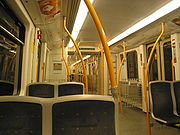
Vienna
Vienna is the capital and largest city of the Republic of Austria and one of the nine states of Austria. Vienna is Austria's primary city, with a population of about 1.723 million , and is by far the largest city in Austria, as well as its cultural, economic, and political centre...
, Austria. The units are designed by Porsche Design Studio
Porsche Design Group
Porsche Design Group , based in Bietigheim-Bissingen, Germany, was founded in November 2003 by as a majority-owned subsidiary of Porsche AG to combine Porsche AG's and Porsche Design Group’s accessories and licensing business into one single company.Originally, there were five independently...
, and have a body in aluminum. A three-car train is 54.14 metre long; the end cars are 18.11 metre long each, while the center car is 17.92 metre long. The cars are 3.16 metre wide and 3.68 metres (12.1 ft) tall. An empty three-car unit weighs 98 tonne, while it with full payload weighs 147 tonne.
Each three-car unit has 138 seats, and a total capacity of 493 riders. There are three doors on each side of each car, measuring 1300 millimetre wide and 1900 millimetre high. In service, the units either run single (with three cars) or two units in multiple
Multiple-unit train control
Multiple-unit train control, sometimes abbreviated to multiple-unit or MU, is a method of simultaneously controlling all the traction equipment in a train from a single location, whether it is a Multiple unit comprising a number of self-powered passenger cars or a set of locomotives.A set of...
(with six cars). Each car is equipped with four three-phase
Three-phase
In electrical engineering, three-phase electric power systems have at least three conductors carrying voltage waveforms that are radians offset in time...
asynchronous
Induction motor
An induction or asynchronous motor is a type of AC motor where power is supplied to the rotor by means of electromagnetic induction. These motors are widely used in industrial drives, particularly polyphase induction motors, because they are robust and have no brushes...
140 kW motors
Electric motor
An electric motor converts electrical energy into mechanical energy.Most electric motors operate through the interaction of magnetic fields and current-carrying conductors to generate force...
, giving each three-car unit a power output of 1680 kW.
The MX3000 introduced a number of technical innovations to the metro. Regenerative brake
Regenerative brake
A regenerative brake is an energy recovery mechanism which slows a vehicle or object down by converting its kinetic energy into another form, which can be either used immediately or stored until needed...
s allow the dynamic brakes to feed the braking energy back to the power system via the third rail. The passengers also have air conditioning
Air conditioning
An air conditioner is a home appliance, system, or mechanism designed to dehumidify and extract heat from an area. The cooling is done using a simple refrigeration cycle...
. The driver's cabs are more ergonomic than in the older models, and the mirrors to monitor the platforms have been replaced with cameras and screens. The trains' livery is white with gray detailing, instead of the former models' red with blue detailing. For use in areas without a third rail, such as at depot
Train station
A train station, also called a railroad station or railway station and often shortened to just station,"Station" is commonly understood to mean "train station" unless otherwise qualified. This is evident from dictionary entries e.g...
s, the trains are equipped with a 110 V battery. This will remove the need for shunting at the depots and cut costs.

